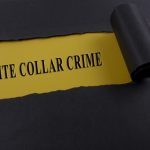White-Collar Crime: Definition, Categories, Evolution and Notable Cases

This article will endeavour to define what is regarded as white collar crime and explore a portion of the multitude of white-collar crimes through the ages, from the litany of the broad variety of crimes which form this type offending. This will include how governments weren’t devoid of becoming criminal offenders of this harmful behaviour.
It will also discuss the aspect of how it is no longer regarded as a crime without violence and will list examples of historical cases after first discussing the origin of this criminal act and other colours of collared crime.
From there, it will be explained why it is so difficult to accurately quantify the cost associated with white-collar crime per se but compensate this with information of the cost of several pertinent offences which are considered part of white-collar offending, specifically pertaining to Australia.
The final portion will discuss aspects of our European partners and how it led to one of Australia’s largest successes against transnational organised crime, in readiness for an upcoming article the subject of which is still being played out in Australia to this day.
The definition
Whilst there are numerous definitions of what constitutes white-collar crime, the Australian Attorney-General’s advice that it understood the terms ‘corporate and financial misconduct’ and ‘white-collar crime’ to:
“…encompass illegal or unethical acts that violate fiduciary responsibility or public trust. These acts may be committed by an individual or organisation and are usually committed during the course of legitimate occupational activity for personal or organisational gain.”
The Australian Federal Police (AFP) explain it as:
The term ‘white-collar crime’ generally refers to financially motivated, non-violent crime and can cover a broad range of criminal conduct. Criminal conduct may occur in the course of the perpetrator’s business or profession. In some cases, perpetrators exploit their social status or that of the business or profession with which they are associated, for example, corporate fraud or corruption. Other offences involve criminal conduct benefiting the proceeds of crime, such as through money laundering.”
Other criminal justice organisations such as the Federal Bureau of Investigation (FBI) speak of it as a violation of trust and deceit stating that it is no longer considered a crime without violence. It is also committed by what is called street crime offenders which are less sophisticated in their offending but no less damaging to society.
Psychological harm is also violence
The World Health Organisation (WHO) confirms that in 1996 the forty-ninth world health assembly adopted a resolution (WHA 49.25) declaring violence a major and growing global public health problem and defined it as: “The intentional use of physical force or power……that either results in or has a high likelihood of resulting in injury, death, psychological harm, maldevelopment or deprivation.”
White-collar crime includes offences such as money laundering – counterfeiting – forgery – embezzlement – bribery (extortion) – identity theft – insider trading – Ponzi schemes – tax fraud and cyber-crime. Blackmail is also considered a form of white-collar crime in certain circumstances.
The origin
This form of offending when first called white-collar crime by reputable criminologist and sociologist, professor Edwin Hardin Sutherland in 1939 was described as:
“A crime committed by a person of respectability and high social status in the course of their occupation.”
Dr Sutherland who completed his Ph. D in sociology at the University of Chicago in 1913 proposed the term to the American Sociological Association (ASA). Whilst at the time it was viewed as a financially motivated and non-violent crime, this would change through the ages.
This is particularly so when one considers the many organised criminal organisations such as the mafia who were also involved in white-collar crime.
In the beginning of the 18th century Daniel Defoe spoke of every degree of business has ‘its invitation to do evil and avarice tempts the rich’. In addition to being an English author, Mr Defoe who wrote ‘Robinson Crusoe’ in 1719 was also a journalist and spy (He became a secret agent for King William III).
Another form of corporate crime is red collar
Many white-collar crime studies including the Canadian center of science and education contradict many of the findings outlined about white-collar crime being a crime without violence, particularly that a significant number of such criminals are indeed violent and have earned the name of Red-Collar criminals.
This term describes their crimes and attributing characteristics as psychopathic, narcissistic and anti-social noting that such criminals are gender-neutral and clearly illustrating that offenders are from all sexes. The study was based on 27 homicides apparently initially from white-collar criminal acts analysed by Frank S Perri JD, CPA, CFE adjunct professor of fraud and forensic accounting who claims to have coined the phrase red-collar.
Different shades of collared crimes
There are other colours which describe some aspects of this form of criminality as outlined in a 1989 study by Dr Kathleen Daly, then of Australia’s Griffith university called ‘Gender and varieties of white-collar crime’ which was covered by journalist Samantha Larson in 2019 who discusses other colours of this type of crime.
Black collar
This colour has at times been used to describe clergy who are charged with a criminal act, though indeed depending on what is alleged may well be dealt with by the church.
Blue collar
Blue is the colour attached to practically all forms of ‘normal’ crimes generally asserted as being committed by working class society members. (but certainly not always)
Green-collar
This colour refers to criminal acts committed against the environment for monetary reward in a variety of ways.
Grey collar
Grey is the colour sometimes attached to perpetrators of most forms of cybercrimes where the victim never meets the perpetrator physically and which affects individuals, organisations and governments.
Pink-collar
The doctor in explaining ‘pink collar’ crime is simply put as being predominantly perpetrated by “lower to mid-level office women who steal from their employers”. Though this is clarified by stating that the pink colour of the crime is not gender biased as it applies to the employed position which also includes men, such as bookkeepers, accountants and secretaries amongst many other office jobs.
There are several other colours associated with the definition attached to collars however these are generally used to describe the type of job the person holds as opposed to the colours referring to a specific crime attached to that position. Orange, purple and gold are those colours.
Historical white-collar crimes
The first recorded case of a white-collar crime that of embezzlement was in England in 1473 when a Flemish businessman subcontracted an Englishman to transport bales of wool to Southampton. The Englishman stole the wool and was charged by police and was convicted for the offence of embezzlement.
The American Civil War was the scene of massive white-collar crime by both Union government and Confederate armies who facilitated amongst many goods, trade in rotten produce including sick horses and defective weaponry causing severe illness and death. It may well have been classified as a war crime such was the scale of the corruption which included many of the aspects which incorporate white-collar crime. This criminal behaviour involved not only manufacturers and suppliers but also alleged involvement by high-ranking officials.
This fraud and similar offending ultimately forced the United States Congress to pass legislation which was the False Claims Act 1863. Despite this law being passed by then President Abraham Lincoln, white-collar crime in its many forms continued throughout the Civil War and post-war reconstruction during the second industrial revolution.
Small business entities grew into corporations then conglomerates necessitating further legislation by way of antitrust laws (then known as competitions laws). This scenario in one form or another was being replicated throughout the world and white-collar crime was in full swing.
Ponzi Schemes are mentioned as one crime associated with white-collar crime. Well forgery, fraud and larceny were the crimes perpetrated by Charles Ponzi an Italian immigrant and swindler predominantly in the 1920s who stole from his investors and served a number of years in Canadian and American prisons prior to being deported. He actually perfected the modus operandi of the crime named after him whilst working as a teller at a Canadian Bank where he rose to be the manager. Ponzi’s company was registered as Securities Exchange Company and at its peak had 75% of Boston’s police force as investors.
Mafia Boss, Alphonse Gabriele Capone (aka Al Capone) was not convicted in 1931 of the slew of other crimes he allegedly committed including the St Valentine’s Day massacre. However, he was sentenced to 11 years imprisonment for evading taxation.
Enron, predominantly an energy company with over 20,000 employees and based in Houston Texas with revenue worth in excess of us$100 billion was subjected to the white-collar crime of accounting fraud. It serviced the United States – Canada – Brazil – India and the Caribbean and filed for bankruptcy in 2001. Shareholders are said to have lost us$74 billion with billions more lost in relation to employees’ pension funds. The president of Enron Jeffrey Keith Skilling received a prison sentence of 24 years. Kenneth Lay who was chairman of Enron died of a heart attack prior to sentencing. It was expected he would have received a significant term of imprisonment.
Andrew Fastow Chief Financial Officer (CFO) received a sentence of imprisonment for 6 years on the provision he give evidence for the prosecution with one Enron executive receiving incarceration for 30 months and another receiving four years’ probation.
WorldCom was one of the largest long-distance telecom companies in America with its market capitalisation reaching us$175 billion at one time after acquiring approximately 30 competing telecom companies. WorldCom filed for bankruptcy with its Chief Executive Officer Bernard Ebbers being imprisoned for 25 years and Scott Sullivan CFO receiving 5 years in prison in return for testifying against his CEO.
One accountant Betty Vinson was imprisoned for five months and another given three years’ probation, its creditors and shareholders receiving a portion of what was owed. Entering bankruptcy in 2002 it emerged in 2004 under a complex restructure plan rebranding itself under the name of one of the telecom companies it had acquired and became known as MCI. 2 years later MCI was purchased by Verizon communications and is today a thriving business.
Bernard Madoff who was the founder of Bernard L. Madoff Investment Securities LLC and had been convicted of a Ponzi scheme fraud amounting to us$65 billion was sentenced in 2009 to 150 years in prison. He didn’t receive a pardon from president Donald Trump as 143 individuals had. He died in 2021 whilst incarcerated.
37,000 people in 136 countries lost money by virtue of Mr Madoff’s offending over 40 years and whilst some investors have been reimbursed with a minor part of their initial investment, some were left destitute. A number committed suicide. This perhaps illustrates why white-collar crime can be a violent crime and is an example of the sort of harm caused by white-collar criminals the world over.
Credit Suisse in 2014 pleaded guilty to aiding U.S. citizens to avoid paying tax to the Inland Revenue Service (IRS) and faced penalties of us$2.6 billion with the Bank of America in a mortgage-backed-securities offence agreeing to pay us$16.5 billion.
Human rights violations during global wars and atrocities
It is interesting that of 39 ‘truth commissions’ throughout time found that in approximately 60% of such commissions mention is made of white-collar criminal offending being complicit in human rights violations throughout the armed conflict and dictatorships. Indeed, only two international courts since World War II have registered guilty verdicts against multi-national companies for corporate complicity in human rights abuses. Domestic courts were somewhat more prevalent in making findings of guilty judgments but still nowhere near that required to do justice to the claims of abuses.
Further cases under study were the World War II offending in Japan, the Rwandan genocide and others.
Cost of white-collar to U.S. society
The U.S. department of justice produced a 26-page paper on precisely why the estimates of what white collar crime costs society are difficult to quantify. Utilising 74 sources of comprehensive research this paper determined that the vast amount of different definitions of what constitutes white collar crime makes it virtually impossible to provide accurate figures.
The U.S. determine it to cost between us$426 billion to us$1.7 trillion annually with the Federal Bureau of Investigation (FBI) estimating it as simply more than us$300 billion annually. However the FBI use a narrow approach by considering white collar crime as “those illegal acts which are characterised by deceit, concealment or violation of trust and which are not dependent upon the application or threat of physical force or violence”.
This may have changed in more recent times as the starting point was altered to being perhaps up to us$660 billion.
Money laundering in the European Union
The money laundering statistics have been difficult to compile accurately for many years now due to the difficulty in measuring precise amounts as a result of being hampered by the clandestine nature of money laundering.
The United Nations on Drugs and Crime (UNODC) say in a 2021 report that it is between 715 billion to 1.87 trillion euros annually which equates to between 2 and 5% of global gross domestic product (GDP).
This is somewhat supported by Eurojust, the European Union agency for criminal justice cooperation report of October 2022 which provides the closest to accurate statistics in this region throughout all comprehensively researched figures.
This recent report is the result of Eurojust’s dedication to forensic analyses over a six-year period and suggests of all the white-collar crimes analysed money laundering accounts for close to 15% of cases reported to Eurojust.
It is still a wide variation though. All 28 European Union member states were involved in money laundering including 60 non-member states with the U.K., U.S, Switzerland and Ukraine being the countries most involved in the laundering transactions.
The issue of accurately estimating statistics associated with cryptocurrency is also highly problematic due to the system attached to the machinations of laundering this form of currency.
The fact is that unlike bank accounts, many thousands of wallets may be opened without proof of identity in a matter of seconds.
Cryptocurrency is a digital currency which is an alternate form of payment where laundering is increasing though it appears to be inconsistent with a general consensus this is due to the high volatility and uncertainty attached to this currency.
Thompson Reuters though in 2022 suggested that Crypto-assets and associated products are rising and have grown rapidly over the past few years with the currency appearing to be making inroads into the regulated money markets.
Europol have a spotlight on this and have been gathering and continue to gather evidence albeit scant to alert all partners within the global criminal justice systems as early as possible of new specific trends in relation to cryptocurrency usage in organised criminal activity and not simply money laundering.
Australian banks involved in white-collar crime
The Commonwealth Bank of Australia (CBA) was found guilty of a white-collar offence in 2018 which involved breaching money-laundering and terrorism finance laws. In 2019 Westpac Banking Corporation (WBC) was found guilty after AUSTRAC traced 23 million breaches of legislation pertaining to money-laundering with a value of AU$11 billion.
The CBA was fined AU$700 million and WBC was fined AU$1.3 billion.
Australian perspective on white-collar crime statistics
Money laundering
According to the AFP Australians are laundering tens of millions of dollars every day with taskforce Averus formed this year to combat this.
Fraud
The Australian competition and consumer commission (ACCC) say that Australians lost $3.1 billion to scams in 2022 which was an 80% increase over total losses in 2021 comprising;
- $1.5 billion in investment scams
- $229.2 million by remote access
- $224.9 million by payment redirection
- $210.2 million in romance scams
- $157.6 million in phishing scams
- $784 million by other means
It is estimated that up to 30% of victims do not report such scams.
Identity Theft
Identity theft as reported by the Australian Institute of Criminology (AIC) estimate that I in 4 Australians are victims of this form of white-collar offence. Recent estimates via the Commonwealth Attorney-General’s department is that this theft costs Australia in excess of $1.6 billion per year.
Bribery
On 18 October 1999, Australia ratified the Organisation for Economic Co-operation and Development (OECD) convention on combating bribery of foreign public officials in international bribery transactions.
In December 2021, Australia provided an addendum to its 2019 report to the convention’s working group on bribery with a final report from Australia anticipated in December 2022. This is in relation to any new corporate offence of failing to prevent foreign bribery which Australia may contemplate and amongst other nations has been slow to respond to.
Whilst it appears that such legislative contemplation has languished over many years without resolution, it is hoped that with a relatively new Australian Government that this may be addressed soon. It appears that with member countries which ratified the convention addressing those matters in a more timely manner, there is a likelihood that the level of enforcement will increase from current levels of low to medium.
This crime is often referred to as corrupt conduct and is considered such a serious threat to the security of Australia in terms of both domestic and foreign bribery that its anti-corruption & bribery laws align with those of the United Nations convention against corruption (UNCAC), United Nations convention against transnational organised crime (UNTOC) and the organisation for economic co-operation and development (OECD) including the convention on combatting bribery of foreign public officials in international business transactions.
Such is how this aspect of white-collar crime could affect each and every Australian in terms of being part of a safe and fair society that it involves input from the Australian Security Intelligence Organisation (ASIO). It also involves similar input from the Australian Criminal Intelligence Commission (ACIC) and the Australian Transaction Reports and Analysis Centre (AUSTRAC).
Of course these Australian government agencies also feature in many aspects of the numerous offences associated with white-collar crime such as bribery and foreign bribery in particular, perhaps even more so.
The main reason why Australia has to address the issue outlined above is that whilst the corruption perceptions index which places a country on the index by virtue of cogent statistics in conjunction with the world’s perceptions are only able to be provided when it stops dragging its feet and enacts legislation as indicated.
This would then improve its position on the index. This appears important in that if Australia improves its position to its 2012 placement of scoring 85 out of a hundred as opposed to its 73 out of a hundred in 2021 it has immense economic benefits for Australia.
Based on economic research over 30 years Melbourne university’s Fellow Tony Ward was comforted by a 2011 meta-analysis for the U.K government by university of London economists Mehmet Ugur and Nandini Dasgupta. In conjunction with data sourced from 12 authoritative institutions Mr Ward a Fellow of history calculates what the value of this could be.
If all the stars were to align Australia would see a GDP per capita growth of 2.2% as opposed to treasury’s forecast of 1.6% which is worth $10 billion. At the same time while the treasury forecast of annual growth from 2022 to 2025 equates to an additional 200,000 jobs annually, this would rise to about 260,000.
The professor is further emboldened with the fact that the 12 authoritative institutions include the World Economic Forum’s executive opinion survey – the World Justice Project’s rule of law index – the Economist Intelligence Unit’s country risk ratings and the World Bank’s policy & institutional assessment.
The upside to all of this is that it is anticipated that the legislation which received royal assent on 12 December 2022 providing for the National anti-corruption commission (NACC) will commence operations in mid-2023.
Cybercrime
REDSPICE is the acronym for Resilience – Effects – Defence – Space – Intelligence – Cyber & Enablers. The Australian Signals Directorate (ASD) formerly the Defence Signals Directorate (DSD) was the recipient of $9.9 billion in the March 2022 budget which is a quarter of the $42 billion which cybercrime cost Australia last financial year according to the University of New South Wales (UNSW) and the Australian Cyber Security Centre (ACSC).
This money will allow the ASD to enhance Australia’s offensive and protective tactics by implementing artificial intelligence (AI) and smart technologies through the REDSPICE program.
This includes not only protection by bringing Australia’s cybersecurity defences and intelligence resources up to an effective standard but also protecting the economy from the numerous threats and other forms of White-Collar offending. Particularly in view of the surge in recent years of digital threats to the economy including our national infrastructure which in turn could threaten Australia’s national security.
The REDSPICE initiative will reduce rates of cybercrime on individuals and businesses both small and large creating savings of countless billions of dollars annually.
Europol
Europol was formerly the European police office amongst other names and is the law enforcement agency for the European Union headquartered in the Hague, Netherlands. It is now known as the European Union agency for law enforcement cooperation and is a highly reputable organisation with approximately 1500 staff.
Australia is a member of Europol having signed the International Treaty in 2007 which authorised the exchange of intelligence.
Eurojust
Eurojust is the European Union agency for criminal justice cooperation and is another criminal justice organisation with an impeccable pedigree in the area of money laundering and other white-collar crimes. It is also situated in the Hague, Netherlands.
In 2019 the AFP led a successful investigation into an illegal remote access hacking tool organisation in conjunction with Eurojust coordinating the international side of the operation including Australia – Colombia – Czechia – Netherlands – Poland – Spain – Sweden and the United Kingdom.
The hacking tool was called IM-RAT an acronym for imminent monitor remote access trojan which was spyware although sold as a legitimate remote management tool for system administrators.
At around the same time Australia was also involved with Europol and Eurojust in an operation with a total of 16 other countries which led to one of Australia’s finest successes against transnational organised crime in over 100 countries.
OTF Greenlight/Trojan Shield 2018 – 2021
Europol’s Deputy Executive Director Jean Philippe Lecouffe naming Australia as integral to the success of the operation said that he was very satisfied to see Europol strengthening law enforcement partnerships … Australian Federal Police Commissioner Reece Kershaw APM stated that Europol is a trusted and committed partner with the AFP providing the technical capability which helped unmask some of the biggest criminals in the world. The AFP went on to execute hundreds of arrest warrants as did many other countries.
In all, 16 countries participated in the world’s largest criminal operation known as OTF (operation task force) Greenlight/Trojan Shield resulting in the initial seizure of in excess of 8 tons of cocaine – 22 tons of Cannabis and its derivative – 2 tons of amphetamine and methamphetamine – 6 tons of synthetic drug precursors – 250 firearms – 55 luxury vehicles including over us$48 million in cash.
Whilst the formal name of the operation was named OTF Greenlight/Trojan Shield it was initially called Greenlight operational task force by Europol, Trojan Shield by the FBI and Ironside by the AFP.
That was simply the start. ANOM is a story for another day.






